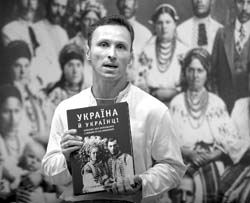<I>Ukraine and Ukrainians</I> in 18 volumes
Unprecedented Ivan Honchar project launched
Two weeks ago the first volume of the unique historical and ethnographic art album Ukraine and Ukrainians: Halychyna and Bukovyna was launched at the Kyiv-based center of Ukrainian folk culture, the Ivan Honchar Museum. This event was also an occasion to honor the memory of Ivan Honchar, the famous artist, sculptor, folk culture researcher, and collector, who died 14 years ago, on June 18.
Honchar is the creator of the monuments and sculptural portraits of Hryhorii Skovoroda in Pereiaslav-Khmelnytsky, Kateryna Bilokur in her native village of Bohdanivka in Kyiv oblast, Ivan Kotliarevsky in Poltava, and Oles Honchar in the Lviv Museum of Ukrainian Art. The artist also paid tribute to Taras Shevchenko: his sculpture Taras the Water-Carrier is displayed the Kaniv-based Shevchenko National Preserve, and a marble statue of the young Taras stands in Moscow’s Tretiakov Gallery. Honchar created a series of pictures portraying various types of ethnic Ukrainians. Traveling across Ukraine, he collected such folk culture artifacts as embroideries, ceramics, pysanky (Ukrainian Easter eggs), icons, and incunabula, which have been exhibited since 1959 in his house, popular known as a “community museum.”
The first volume of this monumental project, Ukraine and Ukrainians: Halychyna and Bukovyna, contains approximately 500 rare originals and photographic reproductions dating to the late 19th-mid-20th centuries, which the collector brought from Western Ukraine, as well as about 200 of his own drawings (he used to draw exhibits items that he could not take with him). For example, one valuable photograph bears the caption, “Ivan Franko is sitting third from right. In the second row on his left is Academician Mykhailo Hrushevsky. Further to the left is the ethnographer Fedir Vovk. Sitting on a cushion is the artist Ivan Trush. Lviv, 1912” Another picture is captioned as follows, “The participants of jubilee celebrations in honor of Mykola Lysenko’s 35-year career as a composer in Lviv. Lysenko is in the middle of the second row. 1905.”
“Honchar first saw Western Ukraine in 1939, when he was mobilized for the Red Army’s so-called liberation march on Galicia,” says Lydia Dubykivska, author of the introductory article to the first volume. “He was struck by an essential difference between what he was seeing and what he had been told earlier, namely, the Galicians’ high educational and cultural level. There was a library almost in every house. Among the mandatory books were the Bible, Taras Shevchenko’s Kobzar, and Mykhailo Hrushevsky’s History of Ukraine-Rus’, which, incidentally, was considered a banned work in Greater Ukraine.”
A year ago a pilot folio entitled Ukraine and Ukrainians: Selected Sheets was published, winning the Grand Prix at the 2006 Publishers’ Forum in Lviv. The entire Honchar album will comprise 18 volumes of materials that this unconventional ethnographer collected over four decades - from the late 1950s until his death in 1993. “Ivan Honchar had the idea not just to create a collection of Ukrainian memorabilia and set up a museum, but above all to re-create the Ukrainian environment that had existed here for centuries and was forcibly destroyed in the early 20th century,” says Ihor Poshyvailo, deputy curator of the Honchar museum and project manager.
“This was an organic environment, in which Ukrainians behaved naturally and with dignity. Honchar’s priority was not the items that he was collecting but the people behind these rarities. I think that for him this was above all the historical and inimitable Ukraine as portrayed in his 18 volumes. In Honchar’s diary we can read that he wanted to expand the number of volumes to 50 or even 100. We hope that this first volume as well as all the subsequent ones now being prepared for publication will make a sizable contribution to modern Ukrainian civilization and ethnological literature, which will enable current and future generations to discover and become aware of their national identity.”






